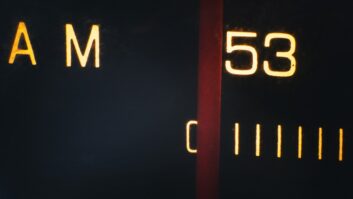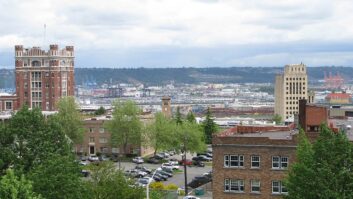The engineering consulting firm of du Treil, Lundin & Rackley says there’s a lot the FCC can do to improve AM.
DLR says the AM band is mature and the agency should not allow more applications for new AMs, given the numerous delivery options available today. “Existing AM stations should be encouraged to improve their service to their actual audiences with as much flexibility as possible in choosing their transmitter site locations and the details of their technical facilities — or get out of the way to let other stations make improvements subject to agreements submitted to the FCC for that purpose,” states DLR in comments filed with the FCC.
Specifically, the agency should not hold any more filing windows for short-form applications, according to the engineering consulting firm, which notes “Much harm has been done to the prospects for improving AM stations in recent years because filing windows were held to allow in short-form applications for new stations and major changes that effectively blocked improvement possibilities for existing stations for years because of the need to protect the new short-form applications based on their assumed facilities. This should never happen again.”
Many of AM’s woes are caused by rising noise levels from items like computers and fluorescent lights. Adopt daytime protected contour levels that are more noise-resistant, advises DLR, suggesting 2.0 mV/m, up from the current 0.5 mV/m for Class B, C and D stations “is more representative of the signal levels needed to overcome present day noise levels.”
Additionally, the 0.1 mV/m daytime protected contour for Class A stations should be raised to 0.5 mV/m, “a change that recognizes the historic wider area coverage of Class A stations for listeners amenable to listening through noise while giving approximately the same decibel increase.”
Further, DLR proposes: “We believe that the rules should be changed to make the protected contour for daytime co-channel overlap, daytime first-adjacent channel overlap, daytime critical hours protection and nighttime overlap from co-channel skywave signals the 0.5 mV/m groundwave contour for Class A stations. In the daytime, this will replace the presently protected 0.1 mV/m contour — which we believe should not be considered a coverage contour under today’s noise conditions. At night, it will replace the 0.5 mV/m skywave contour — which we believe to be obsolete.”
The firm discusses 20+ proposals in its filing.
Several proposals concern skywave protection and how that needs to be reconsidered in the modern age. Of the proposal suggested above, DLR adds: “The proposed daytime change will allow increased flexibility for daytime coverage improvement by co-channel and first-adjacent channel AM stations while still providing a greater degree of protection to Class A stations than what we have proposed for Class B, C and D stations. The proposed 0.5 mV/m protected level will provide for listeners who might be motivated to listen through receiver noise to Class A stations’ programming content, in recognition of Class A stations’ historic role in providing such content to the public.”
Of skywave protection in general, DLR says the radio industry has had a difficult time acknowledging that Class A station 0.5 mV/m nighttime coverage has become obsolete, “because of our own tendency as well as that of others to romanticize listening to distant signals fade in and out overnight and the hobby aspects of ‘DX-ing’ distant signals.” However, the wide area programming that used to be carried overnight by Class As exclusively is distributed to listeners wherever they are with consistent audio quality using other modern technologies like satellite and Internet Protocol delivery, according to the firm. Much of the overnight programming that has historically been provided by Class As has migrated to satellite distribution and IP delivery is threatening to overtake satellite delivery someday soon.
The connected dashboard coming to more vehicles allows more choices of audio programming delivered from more sources. The reality, according to DLR, is listeners who remain for AMs will be there for the programming. AMs need to focus on finding what programming that is and delivering it in a way that competes as well as possible with the other modern-day delivery methods, “meaning with signals optimized for quality reception — something that nighttime skywave service cannot provide.” We hope that “by proposing replacement of obsolete Class A standards with a plan to protect 0.5 mV/m groundwave service, giving Class A stations enhanced protection relative to other classes of stations, we can avoid a situation where lesser protection might be enforced someday,” states DLR.
DLR also discusses FCC proposals and proposals that DLR has offered previously. It’s behind the proposal discussed this fall to open an FM translator window specifically for AM applicants, in a “one per customer” offering.
However DLR cautions the commission that FM translators alone are not the solution. “FM frequency availability will limit the extent to which AM stations are able to use FM translators, particularly in and near larger radio markets.”
The engineering consultants say the daytime community coverage standard should be eliminated and AMs should not be licensed to cover communities, calling the requirement “an obsolete relic” dating from the time when the agency was responsible for rationing frequencies “to be used by the very limited number of radio stations that would provide 100% of the over-the-air entertainment and information available to the public at the time.”
The AM landscape today is far different, “with AM stations providing a very small segment of the electronically-delivered audio content available to the public from an increasingly diverse number of over-the-air sources.” Thus a “radical” change is needed to allow AMs flexibility to see normal business forces guide them in how to best serve their actual audiences, according to DLR.
DLR favors elimination of the so-called “Ratchet Rule,” and wider use of Modulation Dependent Carrier Control technologies.
The engineering consulting firm also favors killing the minimum AM antenna efficiency requirements, noting that the 1930s’era justification for ensuring a minimum amount of service was provided for each of the “scarce AM channel assignments at the time” is no longer enough to justify impairment for flexibility in choosing antenna locations. “AM stations should have complete flexibility in choosing tower height and ground system dimensions and normal business forces can be relied upon to influence their owners to seek optimum locations for serving their audiences,” states DLR.
Comments on AM revitalization are due to MB Docket 13-249 next week. Read DLR’s filing.
Watch our page radioworld.com/amcomments for summaries of other comments to the FCC NPRM.
Related:
Take a Fresh Look at AM Rules










